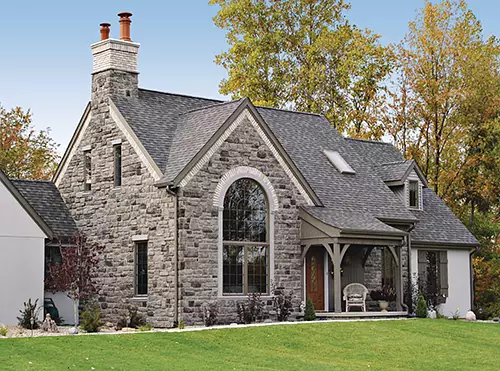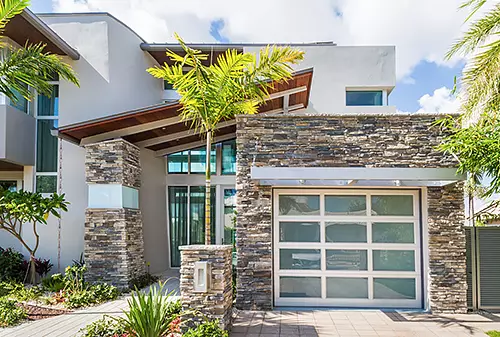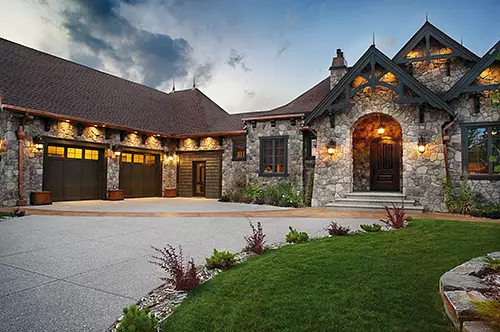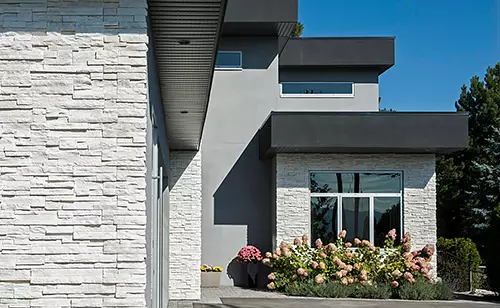Choosing Stone for Your Home's Exterior
by Rachel Lyon, Editorial Director for Direct from the Designers
The exterior of a home provides ample opportunity for customization, so take the time to create awesome curb appeal! Incorporating stone elements is one of the best ways to make a house stand out from the street; not only is stone the most stylistically diverse building material, but it’s also incredibly flexible. Whether you’d like to dress up your foundation or columns, or use stone for some or all of your siding, here’s how you can choose beautiful stone for your façade.

Study Your Architecture
Every kind of architecture has history behind it, and you can use that history to zero in on fitting finishing products. This works because we come to associate certain features with broader design movements—that’s why you’ll automatically think that large, blocky stone is suited to the clean and simple aesthetic of contemporary schemes while irregular river rocks are perfect for rustic cabins and colonials, which were typically built with natural materials available in the area back in the day. So, whatever type of home you have, explore its architectural background. You may just find an example you want to emulate!

Complement Your Surroundings
Unless you plan to build in a very dense area, your lot will provide the foreground and background for your façade. What kind of environment is it? Whether you can see pieces of geological history around or they’re hidden by foliage, it’s a good idea to look for stone that matches the land. You don’t want your home to stick out and look unnatural, after all!
If you aren’t sure what kind of stone is right for your area, don’t fret. Manufacturers produce many varieties of stone in different colors; some are available nationwide while others are only offered in certain regions. Products with limited geographic ranges fill the niche needs of those states, so they often make a great choice. If none of those seem right, a local supplier can always help point you in the right direction and make suggestions.

Consider Shape & Texture
Do you want your home to have a certain look? Perhaps you’d like to really emphasize its architectural background or add some variation to your façade to keep it interesting? This is where the adaptability of stone truly shines! If a chic look is your goal, there are plenty of profiles with crisp edges that’ll deliver. For a more rustic finish, consider unique shapes without square corners and those with multifaceted surfaces that create plenty of highlights and shadows. You can use shape and texture to tailor the appearance of any kind of home—we’ve seen stone act as a neat, modern update to traditional architecture as well as add a rugged, organic touch to contemporary design.

Contrast with Color
Finally, make sure to select stone as part of a fully imagined scheme. Know the colors of your siding, roofing, and other exterior features so you can commit to everything at once, because there’s no guarantee you’ll be able to find complementary products when you lock them in one at a time. In most cases, you want your façade to have enough color contrast that it keeps the eye moving; you don’t want it to look bland, flat, or uniform. You can create appeal whether you opt for distinct stone that’s offset by the rest of the exterior or you stay within the same color family and mix it up with different tones. Don’t think you have to take it to extremes to have an impact!
Take a look at Cultured Stone® if you’d like to add some beautiful stone elements to your home! With a diverse collection of rustic and modern profiles and numerous color blends—many of which replicate the look of natural stone found around the country—you’re sure to find something that works for your design vision. Find a local dealer and start exploring the possibilities today!
BROWSE HOME PRODUCT ARTICLES
- Creating a Spa-Like Master Bathroom »
- Designing a Water-Efficient Bathroom »
- Design a Modern Bathroom »
- View All Bathroom Articles »
- Building a New Home »
- Building a Duplex »
- Finding the Right Home Builder »
- View All Building Tips Articles »
- Adding the Right Columns»
- Decorative Touches for Your Interior»
- Shutters for Every Architectural Style »
- View All Columns & Millwork Articles »
- How to Use Specialty Laminates »
- Decorative Touches for Your Home's Interior
- View All Countertops and Surfaces Articles »
- What Goes Into a Great Deck? »
- Decorative Touches for Your Home's Interior »
- View All Decking Articles »
- Choosing Glass for Your Entry »
- Stylish Personas for Your Front Door »
- Using Sidelites and Transoms »
- View All Door Articles »
- Choose Siding for Your Region »
- Get the Most Out of Exterior Paint »
- Mixing Siding to Define Your Exterior »
- View All Exterior Articles »
- Finding the Right Home Builder »
- The Appeal of Small House Plans »
- Choosing the Perfect Floor Plan »
- View All Finding a Home Plan Articles »
- Colorful Flooring for Your Home »
- Designing With Different Widths»
- Chic, Neutral, Gray Flooring »
- View All Flooring Articles »
- Garage Doors That Add Curb Appeal »
- Caring for Your Garage Doors »
- Benefits of Insulated Garage Doors »
- View All Garage Door Articles »
- Reclaimed Products for Your Home »
- Building a Green and Stylish Home »
- Benefits of Building with SIPS »
- View All Green Building Articles »
- Cool Gadgets for Your New Home »
- Creating a Hi-Tech Home »
- Efficient Gifts for New Homeowners »
- View All Home Electronics Articles »
- Improve Your Home's Air Circulation »
- How to Improve the Air Circulation in Your Home »
- View All HVAC Articles »
- Bedrooms Designed for Sleep »
- Selecting a Fireplace for Your Home »
- Crafting a Luxurious Master Suite »
- View All Interior Design Articles »
- Design the Perfect Outdoor Space »
- Dive into a Beautiful Pool »
- Design a Sizzling Outdoor Kitchen »
- View All Outdoor Living Articles »
- Apps to Help You Pick Paint Colors »
- Create the Perfect Mood with Paint »
- How to Read the Color Wheel »
- View All Painting & Decorating Articles»
- Creating a Spa-Like Master Bathroom »
- High-Impact Kitchen Upgrades »
- Creating a Water Efficient Bathroom »
- View All Plumbing Fixtures Articles»
- Cladding That Complements Your Exterior »
- Reasons to Consider Prefinished Siding »
- View All Siding & Cladding Articles»
- All About Solar Powered Skylights »
- Natural Lighting for the Dark Corners of Your Home »
- Design a Better Bedroom with Skylights »
- View All Skylight Articles»
.png)
.png)
